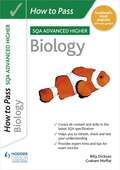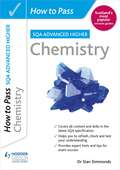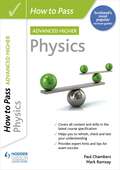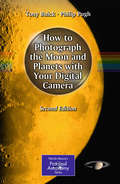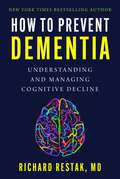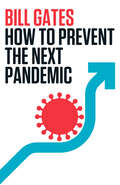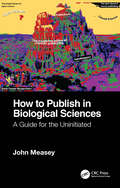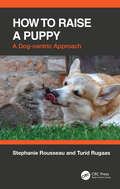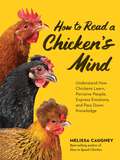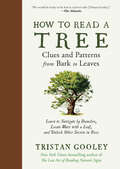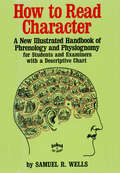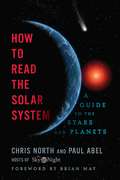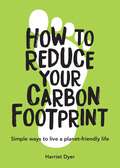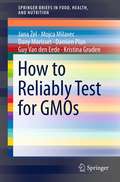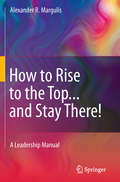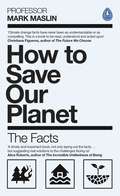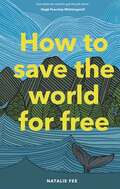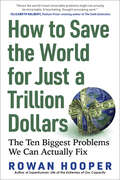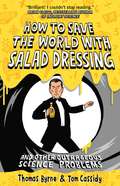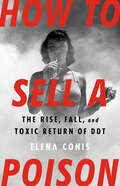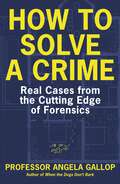- Table View
- List View
How to Pass SQA Advanced Higher Biology
by Graham Moffat Billy DicksonExam board: SQALevel: Advanced HigherSubject: BiologyFirst teaching: August 2019First exam: Summer 2021Trust Scotland's most popular revision guides to deliver the results you want. The How to Pass series is chosen by students, parents and teachers again and again.This is the only study book that addresses the skills for Advanced Higher Biology, as well as the knowledge.> Recap and remember course content. Concise summaries and diagrams cover the important points for each Key Area in the latest SQA specification.> Test your skills and knowledge. Regular 'check-up' questions throughout the text help you to see if a topic is secure before you move on. This style of active revision is much more effective than simply reading.> Practise exam-style questions. Formal questions with mark allocations are provided at the end of each Key Area, reflecting the types of questions you will face in the exam. Three course assessments are also included.> Get expert tips for exam success. Hints on how to achieve top marks and avoid mistakes are based on feedback in the SQA examiners' Course Reports, giving you insight into the marking process.> Teach yourself with confidence. Independent study has never been easier with clear explanations, definitions of technical terms and answers to all questions at the back of the book.> Plan and manage your revision. Checklists for each Key Area enable you to benchmark your progress against SQA's assessment standards and make sure you're on track to get the grades you need.
How to Pass SQA Advanced Higher Chemistry
by Dr Sian SimmondsExam board: SQALevel: Advanced HigherSubject: ChemistryFirst teaching: August 2019First exam: Summer 2021Trust Scotland's most popular revision guides to deliver the results you want. The How to Pass series is chosen by students, parents and teachers again and again.This is the only study book that addresses the skills for Advanced Higher Chemistry, as well as the knowledge.> Recap and remember course content. Concise summaries and diagrams cover the important points for each Key Area in the latest SQA specification.> Test your skills and knowledge. Regular 'check-up' questions throughout the text help you to see if a topic is secure before you move on. This style of active revision is much more effective than simply reading.> Practise exam-style questions. Formal questions with mark allocations are provided at the end of each Key Area, reflecting the types of questions you will face in the exam.> Get expert tips for exam success. Hints on how to achieve top marks and avoid mistakes are based on feedback in the SQA examiners' Course Reports, giving you insight into the marking process.> Teach yourself with confidence. Independent study has never been easier with clear explanations, definitions of technical terms and answers to all questions at the back of the book.> Plan and manage your revision. Checklists for each Key Area enable you to benchmark your progress against SQA's assessment standards and make sure you're on track to get the grades you need.
How to Pass SQA Advanced Higher Chemistry
by Sian SimmondsExam board: SQALevel: Advanced HigherSubject: ChemistryFirst teaching: August 2019First exam: Summer 2021Trust Scotland's most popular revision guides to deliver the results you want. The How to Pass series is chosen by students, parents and teachers again and again.This is the only study book that addresses the skills for Advanced Higher Chemistry, as well as the knowledge.> Recap and remember course content. Concise summaries and diagrams cover the important points for each Key Area in the latest SQA specification.> Test your skills and knowledge. Regular 'check-up' questions throughout the text help you to see if a topic is secure before you move on. This style of active revision is much more effective than simply reading.> Practise exam-style questions. Formal questions with mark allocations are provided at the end of each Key Area, reflecting the types of questions you will face in the exam.> Get expert tips for exam success. Hints on how to achieve top marks and avoid mistakes are based on feedback in the SQA examiners' Course Reports, giving you insight into the marking process.> Teach yourself with confidence. Independent study has never been easier with clear explanations, definitions of technical terms and answers to all questions at the back of the book.> Plan and manage your revision. Checklists for each Key Area enable you to benchmark your progress against SQA's assessment standards and make sure you're on track to get the grades you need.
How to Pass SQA Advanced Higher Physics
by Paul Chambers Mark RamsayExam board: SQALevel: Advanced HigherSubject: PhysicsFirst teaching: August 2019First exam: Summer 2021Trust Scotland's most popular revision guides to deliver the results you want. The How to Pass series is chosen by students, parents and teachers again and again.This is the only study book that addresses the skills for Advanced Higher Physics, as well as the knowledge.> Recap and remember course content. Concise summaries and diagrams cover the important points for each Key Area in the latest SQA specification.> Test your skills and knowledge. Regular 'check-up' questions throughout the text help you to see if a topic is secure before you move on. This style of active revision is much more effective than simply reading.> Practise exam-style questions. Formal questions with mark allocations are provided at the end of each Key Area, reflecting the types of questions you will face in the exam.> Get expert tips for exam success. Hints on how to achieve top marks and avoid mistakes are based on feedback in the SQA examiners' Course Reports, giving you insight into the marking process.> Teach yourself with confidence. Independent study has never been easier with clear explanations, definitions of technical terms and answers to all questions at the back of the book.> Plan and manage your revision. Checklists for each Key Area enable you to benchmark your progress against SQA's assessment standards and make sure you're on track to get the grades you need.
How to Photograph the Moon and Planets with Your Digital Camera
by Tony Buick Philip PughAlthough astronomical CCD cameras can be very costly, digital cameras - the kind you use on holiday - on the other hand, are relatively inexpensive. Moreover, their technology - especially thermal noise, sensitivity (ISO number) and resolution - has progressed to a point where such cameras are more than capable of photographing the brighter astronomical objects. Now Tony Buick has teamed up with fellow author and astro imager Phil Pugh, to produce a completely revised, updated, and extended second edition to How to Photograph the Moon and Planets with your Digital Camera, first published in 2006. The revisions take into account changing (and improving) camera technology, and some items which are now available commercially but which previously had to be home-made. The section of solar observing has been expanded to include observing by H-alpha light, and among the many additional sections are photographing the constellations, aurorae, and basic post-imaging processing.
How to Prevent Dementia: Understanding and Managing Cognitive Decline
by Richard RestakA comprehensive guide to preventing Alzheimer&’s and other thinking disorders from bestselling author and renowned authority Dr. Richard Restak!How to Prevent Dementia begins with the principle that the more we know about dementia, the easier it is to prevent or delay it. A better foundation of knowledge also helps people to understand and interact thoughtfully with family members and other loved ones who may have Alzheimer&’s and other dementias. Dr. Restak examines the basic thinking of normal everyday people and progresses to people with thinking disorders. In understanding that dementias exist along a continuum, starting with perfectly normal performance and ending at the extremes of mental dysfunction, we learn how our attention to everyday habits, choices, and behaviors can affect where we are located along that continuum, as well as whether or how we will progress from one part to another. As can be gleaned from recent reports, researchers may be on the cusp of a meaningful treatment or cure for Alzheimer&’s. Dr. Restak also helps the reader to grasp both the positive and challenging consequences of the new medications that will soon be available. At the end of the book, the reader will understand what practical steps can be taken each day to lessen the odds of dementia and how to take advantage of new medications, while gaining a better understanding of thinking and what it is like to have it falter.
How to Prevent the Next Pandemic
by Bill GatesFrom the author of the #1 New York Times best seller How to Avoid a Climate Disaster: The COVID-19 pandemic isn&’t over, but even as governments around the world strive to put it behind us, they&’re also starting to talk about what happens next. How can we prevent a new pandemic from killing millions of people and devastating the global economy? Can we even hope to accomplish this?Bill Gates believes the answer is yes, and in this book he lays out clearly and convincingly what the world should have learned from COVID-19 and what all of us can do to ward off another disaster like it. Relying on the shared knowledge of the world&’s foremost experts and on his own experience of combating fatal diseases through the Gates Foundation, he first helps us understand the science of infectious diseases. Then he shows us how the nations of the world, working in conjunction with one another and with the private sector, can not only ward off another COVID-like catastrophe but also eliminate all respiratory diseases, including the flu. Here is a clarion call—strong, comprehensive, and of the gravest importance—from one of our greatest and most effective thinkers and activists.
How to Publish in Biological Sciences: A Guide for the Uninitiated
by John MeaseyThis book is a guide specifically for Early Career Researchers on how to publish in the Biological Sciences, whether that be your first manuscript or if you’re already experienced – there’s something for everyone.Following on from How to Write a PhD in Biological Sciences: A Guide for the Uninitiated, it will guide you through taking your manuscript to publication in peer-reviewed journals and disseminating your research more broadly. It talks you through the peer-review process, including how to respond to reviewers’ comments, the meaning and importance of Impact Factors and how to get citations. It also explores the challenges in the academic community around Open Access and other debates, including transparency, overlay journals, paywalls, publication bias, predatory journals and the dangers of bullying.Whether you are a student just completing your studies, or a supervisor struggling with rejections, this book will provide the insider information you need to get ahead.
How to Raise a Puppy: A Dog-centric Approach
by Stephanie Rousseau Turid RugaasHow to Raise a Puppy moves away from the traditional approach to raising puppies, focused on obedience and control, and instead takes an holistic, dog-centred approach. Drawing on research into how dogs naturally rear their young, and how dogs have evolved to behave and spend their time, it supports a new way of sharing our lives with our dogs. It also offers advice on dealing with some of the common challenges people experience with puppies, and tips for managing adolescence. A much-needed resource for dog trainers, veterinarians and behaviourists to recommend to clients, this conveys a powerful message to help overcome all too common issues so many people have with their puppies. Packed with practical advice, it offers an overdue "puppy perspective", with respect for a dog as a sentient being at its core.
How to Read a Chicken's Mind: Understand How Chickens Learn, Perceive People, Express Emotions, and Pass Down Knowledge
by Melissa CaugheyA bestselling author and expert on chicken behavior leads readers into the surprisingly complex inner workings of a chicken's brain. Backyard chicken keeper Melissa Caughey shares her years of experience and research about our feathered friends with this entertaining and informative exploration of what chickens think and feel. From chick days to the golden stage of "henopause," Caughey offers insights into the range of feelings that chickens can express, their unexpected intelligence, personality types, and flock dynamics.
How to Read a Tree: Clues And Patterns From Bark To Leaves (Natural Navigation #0)
by Tristan Gooley“Reams of appealing facts make one itch to get outside and right up close to trees’ rough surfaces and shady cover.”—The Atlantic New York Times–bestselling author Tristan Gooley opens our eyes to the secret language of trees—and the natural wonders they reveal all around us Trees are keen to tell us so much. They’ll tell us about the land, the water, the people, the animals, the weather, and time. And they will tell us about their lives, the good bits and bad. Trees tell a story, but only to those who know how to read it. In How to Read a Tree, Gooley uncovers the clues hiding in plain sight: in a tree’s branches and leaves; its bark, buds, and flowers; even its stump. Leaves with a pale, central streak mean that water is nearby. Young, low-growing branches show that a tree is struggling. And reddish or purple bark signals new growth. Like snowflakes, no two trees are exactly the same. Every difference reveals the epic story this tree has lived—if we stop to look closely.
How to Read Character
by Samuel R. WellsHere is a book with a lot of character-in fact, many characters, some famous and others infamous, from misers and murderers to presidents, philosophers and plenipotentiaries. These many and varied personalities are presented as illustrations of character traits.Certainly a new audience of readers will find many things in the book to enjoy and to ponder as well.
How to Read the Solar System: A Guide to the Stars and Planets
by Brian May Chris North Paul AbelA fresh and essential guide to understanding and interpreting the wonders of our solar system, from two intrepid young astronomers who are the hosts of the popular BBC television series, "The Sky at Night." What exactly is the solar system? We've all learned the basics at school but do we really understand what we are seeing in the night sky? Expert astronomers Chris North and Paul Abel, provide a fascinating guided tour of our Solar System and explain its many wonders. They look at all the major players, including our more familiar cosmic neighbors--the Sun, the planets and their moons--as well as the occasional visitors to our planet--asteroids, meteors and comets--in addition to distant stars and what might lie beyond our Solar System, including the mysterious Earth Mark II? North and Abel recount the history of how our Solar System came to be, and the myths that once shaped astronomy. Through their cogent explanations of the latest scientific discoveries, they reveal how any amateur astronomer can view and interpret the Solar System and enrich their understanding of our universe.
How to Reduce Your Carbon Footprint: Simple Ways to Live a Planet-Friendly Life
by Harriet DyerDo you ever feel overwhelmed by the thought of the climate emergency?Do you want an eco-friendly lifestyle but don’t know where to start?Then dive into this little book, full of simple, achievable ways to help you reduce your carbon footprint. From tips on creating a more eco-friendly home and ways to reduce your plastic use, to advice on shopping sustainably, within these pages you will discover everything you need to know to help you make planet-friendly choices and live a more sustainable life.
How to Reliably Test for GMOs
by Dany Morisset Kristina Gruden Damien Plan Jana Žel Mojca Milavec Guy Van den EedeThe detection of genetically modified organisms (GMOs) is becoming very complex, with new GMOs, approved and unapproved, constantly entering world markets. Traceability and labelling of GMOs is defined in regulations worldwide, demanding accurate and reliable testing to support the requirements of legislation. This Brief provides the current state-of-the-art on all key topics involved in GMO testing and is a source of detailed practical information for laboratories. Special focus is given to qualitative and quantitative real-time PCR analysis relevant to all areas where detection and identification rely on nucleic acid-based methods. The following topics, important for testing laboratories, are also discussed: organization of the laboratory, focusing on aspects of the quality system and methods for testing, validation and verification of methods, and measurement uncertainty. The Brief also discusses the new challenges of GMOs and novel modified organisms, using new technologies, and the possible solutions for GMO detection, including bioinformatics tools. Finally, legislation on GMOs and sources of information on GMOs are provided, which are relevant not only to testing laboratories, but to anyone interested in GMOs. The authors of this Brief have many years of experience in GMO testing, development of real-time PCR methods, implementation of quality system requirements, validations and verification of methods, and measurement uncertainty. The National Institute of Biology is a highly qualified research laboratory and a National Reference Laboratory, which also performs routine analyses of food, feed and seed. The Institute for Health and Consumer Protection of the European Union Joint Research Centre has extensive knowledge and experience of GMO detection. It hosts the European Union Reference Laboratory for GM Food and Feed in addition to chairing the European Network of GMO Laboratories.
How to Rise to the Top...and Stay There!
by Alexander R. MargulisThe present dire economic environment has greatly affected business and the opportunities for advancement or even holding a job. Even universities, although not directly in business, are feeling the impact of diminishing endowments, resulting in lower disposable funds and reduction in innovative, unproven programs, which, in the past, often led to breakthroughs. These conditions we hope are only temporary, and they will not affect careers in the long run. This book is written to guide the reader on how to progress in his or her chosen career, how to reach a high position in which one is actually in charge of a unit, department, school, or business and how to run it successfully.
How To Save Our Planet: The Facts
by Mark A. Maslin'Punchy and to the point. No beating around the bush. This brilliant book contains all the information we need to have in our back pocket in order to move forward' Christiana Figueres, Former Executive Secretary UN Climate Change Convention'Amazing book' Chris Evans, Virgin Radio Breakfast Show'Everyone should have this book' Rick Edwards, BBC Radio 5 Live'A timely and important book, not only laying out the facts...but suggesting real solutions to the challenges facing us' Professor Alice Roberts, Anatomist, Professor of Public Engagement in Science, University of Birmingham_________________________ How can we save our planet and survive the 21st century? How can you argue with deniers? How can we create positive change in the midst of the climate crisis? Professor Mark Maslin has the key facts that we need to protect our future. Global awareness of climate change is growing rapidly. Science has proven that our planet and species are facing a massive environmental crisis. How to Save Our Planet is a call to action, guaranteed to equip everyone with the knowledge needed to make change. Be under no illusion the challenges of the twenty-first century are immense. We need to deal with: climate change, environmental destruction, global poverty and ensure everyone's security. We have the technology. We have the resources. We have the money. We have the scientists, the entrepreneurs and the innovators. We lack the politics and policies to make your vision of a better world happen. So we need a plan to save our planet... How to Save Our Planet is your handbook of how we together can save our precious planet. From the history of our planet and species, to the potential of individuals and our power to create a better future, Maslin inspires optimism in these bleak times. We stand at the precipice. The future of our planet is in our hands. It's time to face the facts and save our planet from, and for, ourselves._________________________'A handbook of clearly established, authoritative facts and figures about the terrible toll we as humans have taken of our planet, plus ways in which we can lessen the impact. For laypeople like me, who can see what is happening but haven't always got the precise statistics to hand, it's hugely valuable' John Simpson CBE, BBC World Affairs Editor, Broadcaster, Author & Columnist'Saving the world is no small thing, but picking up this book's a good start' Paris Lees, Contributing Editor at British Vogue, campaigner'I love it. My kids love it' Chris Evans, Virgin Radio Breakfast Show'A no-nonsense crib sheet on the state of the world and how to help it' The I Newspaper
How to Save the World for Free: (guide To Green Living, Sustainability Handbook)
by Natalie Fee“Just what we need to get the job done†- Hugh Fearnley-WhittingstallAre you worried about the effects of climate change on our environment? Want to help but don’t know where to start? Natalie Fee’s new handbook to green living will help you to make small lifestyle changes which will make a big difference to our planet.We know that a better world is possible. One where we all get to breathe clean air, marvel at the abundance of wildlife and enjoy life without worrying if it’s about to self-destruct. But how do we get there? And can it really be … easy? And fun? And free?How to Save the World for Free by environmental campaigner Natalie Fee will galvanise you to think and live differently, covering all key areas of our lives, from food and travel to politics and sex, author and environmental campaigner Natalie Fee will galvanise you to think and live differently. You will feel better, live better and ultimately breathe better in the knowledge that every small change contributes towards saving our world.Examples of Natalie’s tips include voting with climate change policies in mind, carrying a reusable coffee cup, buying bamboo toothbrushes, packaging-free toiletries and ditching plastic based pads and tampons in favour of a menstrual cup, all of which will reduce your environmental impact while also saving you money.Unlike other guides to green living, How to Save the World For Free also addresses the big barriers to change, including broken political systems, capitalism and consumerism – and gives us practical and engaging ways to disrupt them.Perfect for fans of Lucy Siegle's Turning the Tide on Plastic and Greta Thunberg’s No One is Too Small to Make a Difference.Whether you are a signed-up member of Extinction Rebellion or if you’re just starting out on your environmental journey, How to Save the World for Free includes helpful and approachable advice for everyone. Let’s save the world together!#HowToSaveTheWorldForFree10% of all profits from the book will go to City to Sea, a non-profit organisation running campaigns to stop plastic pollution at source.Watch Natalie’s TEDx talk on the devastating effect of plastic in our oceans here: https://bit.ly/2N1mzlrThis book has been printed on FSC-certified paper and uses nontoxic vegetable-based inks.Laurence King Publishing is committed to ethical and sustainable production, and are proud participants in The Book Chain Project ® bookchainproject.com
How to Save the World For Free: (guide To Green Living, Sustainability Handbook)
by Natalie Fee“Just what we need to get the job done” - Hugh Fearnley-WhittingstallAre you worried about the effects of climate change on our environment? Want to help but don’t know where to start? Natalie Fee’s new handbook to green living will help you to make small lifestyle changes which will make a big difference to our planet.We know that a better world is possible. One where we all get to breathe clean air, marvel at the abundance of wildlife and enjoy life without worrying if it’s about to self-destruct. But how do we get there? And can it really be … easy? And fun? And free?How to Save the World for Free by environmental campaigner Natalie Fee will galvanise you to think and live differently, covering all key areas of our lives, from food and travel to politics and sex, author and environmental campaigner Natalie Fee will galvanise you to think and live differently. You will feel better, live better and ultimately breathe better in the knowledge that every small change contributes towards saving our world.Examples of Natalie’s tips include voting with climate change policies in mind, carrying a reusable coffee cup, buying bamboo toothbrushes, packaging-free toiletries and ditching plastic based pads and tampons in favour of a menstrual cup, all of which will reduce your environmental impact while also saving you money.Unlike other guides to green living, How to Save the World For Free also addresses the big barriers to change, including broken political systems, capitalism and consumerism – and gives us practical and engaging ways to disrupt them.Perfect for fans of Lucy Siegle's Turning the Tide on Plastic and Greta Thunberg’s No One is Too Small to Make a Difference.Whether you are a signed-up member of Extinction Rebellion or if you’re just starting out on your environmental journey, How to Save the World for Free includes helpful and approachable advice for everyone. Let’s save the world together!#HowToSaveTheWorldForFree10% of all profits from the book will go to City to Sea, a non-profit organisation running campaigns to stop plastic pollution at source.Watch Natalie’s TEDx talk on the devastating effect of plastic in our oceans here: https://bit.ly/2N1mzlrThis book has been printed on FSC-certified paper and uses nontoxic vegetable-based inks.Laurence King Publishing is committed to ethical and sustainable production, and are proud participants in The Book Chain Project ® bookchainproject.com
How to Save the World for Just a Trillion Dollars: The Ten Biggest Problems We Can Actually Fix
by Rowan HooperWhat would you do with a trillion dollars? The ultimate thought experiment opens our eyes to ten world-changing ideas within our grasp If we can come up with a trillion dollars to bail out banks, imagine what else we could do. Science journalist Rowan Hooper decided to find out, speaking with experts of all kinds about ten incredibly ambitious projects that— if realized—would secure profound, enduring benefits: trying to end global poverty, reverse climate change, extend our lifespans, refreeze the Arctic, save all endangered species, and more. Then, he dives into strategies and costs to see: How far would $1 trillion really go? You’ll have to read on to learn which project he concludes would do the most good . . . but the biggest surprise is how many astonishing advances are actually within our grasp—if we dare to reach for them.
How To Save the World with Salad Dressing: and Other Outrageous Science Problems
by Thomas Byrne Tom CassidyWho said that physics has to be dull? In this rip-roaring science puzzle adventure, Byrne and Cassidy put the reader in the driving seat. Is a truck containing a bird lighter when the bird is flying or on a perch? Why does the stream from a tap get increasingly thinner? Can you speed up light? Is time travel possible? Featuring a cast of odd-ball characters and a laugh-out-loud storyline, Byrne and Cassidy explain the basic principles of modern science and guide the reader in working out the rest. With thirty stimulating mindbenders of varying difficulty, including detailed clues and answers for each problem, How to Save the World with Salad Dressing is the perfect book for anyone with an interest in science or mathematics. Thomas Byrne is a fledgling genius and professional puzzle writer. Thomas Cassidy is former teacher and Oxford University Physics graduate. He is married to a Texan and spends much of the year in Austin. They are the authors of How to Win at Russian Roulette: And Other Outrageous Logic Problems
How to Sell a Poison: The Rise, Fall, and Toxic Return of DDT
by Elena ConisThe story of an infamous poison that left toxic bodies and decimated wildlife in its wake is also a cautionary tale about how corporations stoke the flames of science denialism for profit.The chemical compound DDT first earned fame during World War II by wiping out insects that caused disease and boosting Allied forces to victory. Americans granted it a hero&’s homecoming, spraying it on everything from crops and livestock to cupboards and curtains. Then, in 1972, it was banned in the US. But decades after that, a cry arose to demand its return. This is the sweeping narrative of generations of Americans who struggled to make sense of the notorious chemical&’s risks and benefits. Historian Elena Conis follows DDT from postwar farms, factories, and suburban enclaves to the floors of Congress and tony social clubs, where industry barons met with Madison Avenue brain trusts to figure out how to sell the idea that a little poison in our food and bodies was nothing to worry about.In an age of spreading misinformation on issues including pesticides, vaccines, and climate change, Conis shows that we need new ways of communicating about science—as a constantly evolving discipline, not an immutable collection of facts—before it&’s too late.
How to Shoot an Amateur Naturalist
by Gerald DurrellThis story of his journey is vintage Durrell: breezy and entertaining as he recounts misadventures and the problems of filming wild animals, serious in his plea for conservation.
How to Solve a Crime: Stories from the Cutting Edge of Forensics
by Professor Angela GallopOut now: The gripping new book by the UK's most eminent forensic scientists, Angela Gallop__________CRIME [Noun]: An action or omission which constitutes an offence and is punishable by lawForensic science is one of the most important aspects of any criminal investigation.The impartial and objective evidence it provides can help convict the innocent and incarcerate the guilty. It enables courts to have the confidence in their decisions and to ensure that justice is done. Professor Angela Gallop has been at the forefront of forensics for more than 45 years. During her remarkable career, she has established and run forensic science laboratories and has worked on thousands of cases in the UK and across the world. In How to Solve a Crime, she describes some of her own and her colleagues most intriguing cases and the wide range of skills and techniques used to solve them. Whether it's looking at blood patterns and footwear marks at crime scenes to work out what happened, extracting data from suspects mobile phones to discover where they were at critical times, or analysing fragments of textiles fibers, glass or paint to determine where they might have come from, Gallop shows that every contact really does leave a trace and every trace can help to solve a crime. With unparalleled access and insight across a wide range of specialisms, How to Solve a Crime is a fascinating definitive and authoritative account of real-life forensic science. _________Praise for WHEN THE DOGS DON'T BARK'Fascinating' Guardian 'Offers a chilling glimpse into her life's work. . . fascinating stuff' Sunday Times 'Compelling' Daily Mirror 'A casebook that reads like The Encyclopaedia of Murder' Daily Express 'One of the professions leading lights' Woman & Home
How to Solve a Crime: Stories from the Cutting Edge of Forensics
by Professor Angela GallopPre-order now: The gripping new book by the UK's most eminent forensic scientists, Angela Gallop__________CRIME [Noun]: An action or omission which constitutes an offence and is punishable by lawForensic science is one of the most important aspects of any criminal investigation.The impartial and objective evidence it provides can help convict the innocent and incarcerate the guilty. It enables courts to have the confidence in their decisions and to ensure that justice is done. Professor Angela Gallop has been at the forefront of forensics for more than 45 years. During her remarkable career, she has established and run forensic science laboratories and has worked on thousands of cases in the UK and across the world. In How to Solve a Crime, she describes some of her own and her colleagues most intriguing cases and the wide range of skills and techniques used to solve them. Whether it's looking at blood patterns and footwear marks at crime scenes to work out what happened, extracting data from suspects mobile phones to discover where they were at critical times, or analysing fragments of textiles fibers, glass or paint to determine where they might have come from, Gallop shows that every contact really does leave a trace and every trace can help to solve a crime. With unparalleled access and insight across a wide range of specialisms, How to Solve a Crime is a fascinating definitive and authoritative account of real-life forensic science. _________Praise for WHEN THE DOGS DON'T BARK'Fascinating' Guardian 'Offers a chilling glimpse into her life's work. . . fascinating stuff' Sunday Times 'Compelling' Daily Mirror 'A casebook that reads like The Encyclopaedia of Murder' Daily Express 'One of the professions leading lights' Woman & Home
